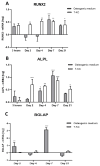7-Ketocholesterol Effects on Osteogenic Differentiation of Adipose Tissue-Derived Mesenchymal Stem Cells
- PMID: 39518932
- PMCID: PMC11545361
- DOI: 10.3390/ijms252111380
7-Ketocholesterol Effects on Osteogenic Differentiation of Adipose Tissue-Derived Mesenchymal Stem Cells
Abstract
Some oxysterols were shown to promote osteogenic differentiation of mesenchymal stem cells (MSCs). Little is known about the effects of 7-ketocholesterol (7-KC) in this process. We describe its impact on human adipose tissue-derived MSC (ATMSC) osteogenic differentiation. ATMSCs were incubated with 7-KC in osteogenic or adipogenic media. Osteogenic and adipogenic differentiation was evaluated by Alizarin red and Oil Red O staining, respectively. Osteogenic (ALPL, RUNX2, BGLAP) and adipogenic markers (PPARƔ, C/EBPα) were determined by RT-PCR. Differentiation signaling pathways (SHh, Smo, Gli-3, β-catenin) were determined by indirect immunofluorescence. ATMSCs treated with 7-KC in osteogenic media stained positively for Alizarin Red. 7-KC in adipogenic media decreased the number of adipocytes. 7-KC increased ALPL and RUNX2 but not BGLAP expressions. 7-KC decreased expression of PPARƔ and C/EBPα, did not change SHh, Smo, and Gli-3 expression, and increased the expression of β-catenin. In conclusion, 7-KC favors osteogenic differentiation of ATMSCs through the expression of early osteogenic genes (matrix maturation phase) by activating the Wnt/β-catenin signaling pathway, while inhibiting adipogenic differentiation. This knowledge can be potentially useful in regenerative medicine, in treatments for bone diseases.
Keywords: 7-KC; Wnt/β-catenin; adipose tissue; mesenchymal stem cell; osteogenic differentiation; oxysterol.
Conflict of interest statement
The authors declare no conflicts of interest.
Figures




References
-
- Frank V., Kaufmann S., Wright R., Horn P., Yoshikawa H.Y., Wuchter P., Madsen J., Lewis A.L., Armes S.P., Ho A.D., et al. Frequent mechanical stress suppresses proliferation of mesenchymal stem cells from human bone marrow without loss of multipotency. Sci. Rep. 2016;6:24264. doi: 10.1038/srep24264. - DOI - PMC - PubMed
MeSH terms
Substances
Grants and funding
LinkOut - more resources
Full Text Sources
Miscellaneous

